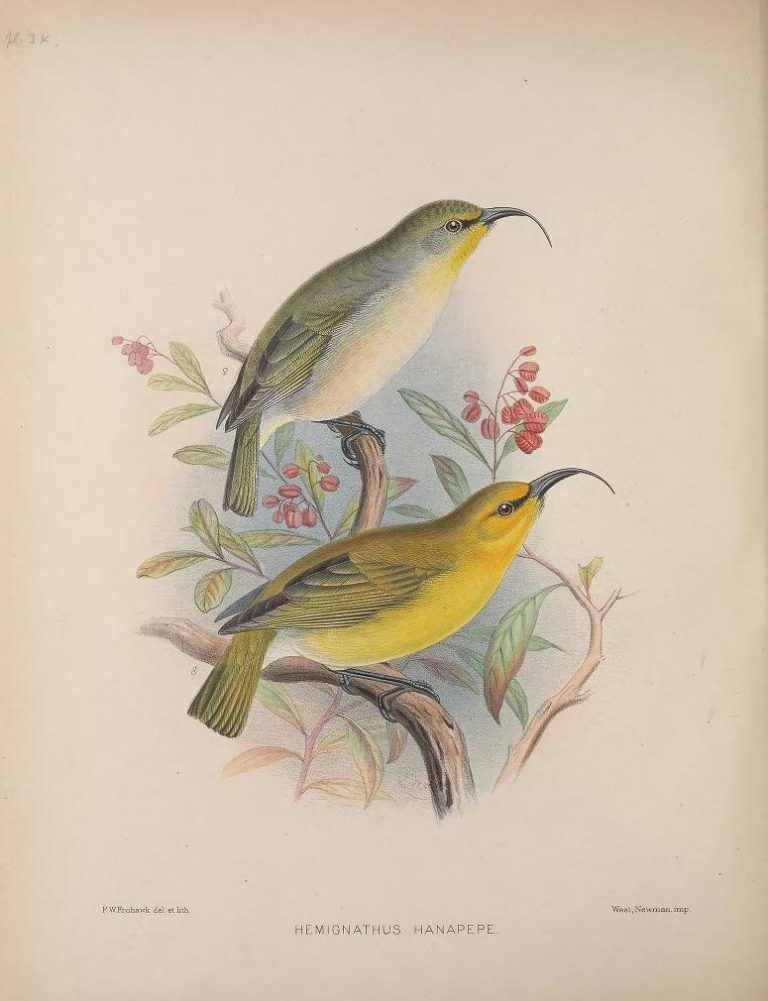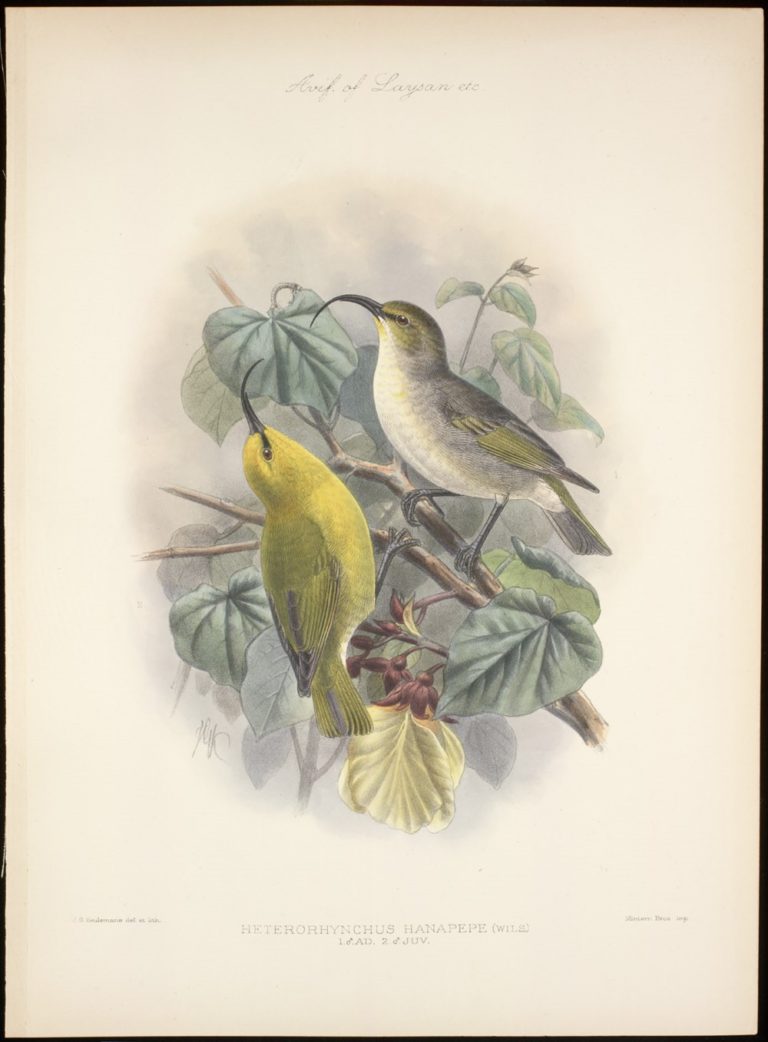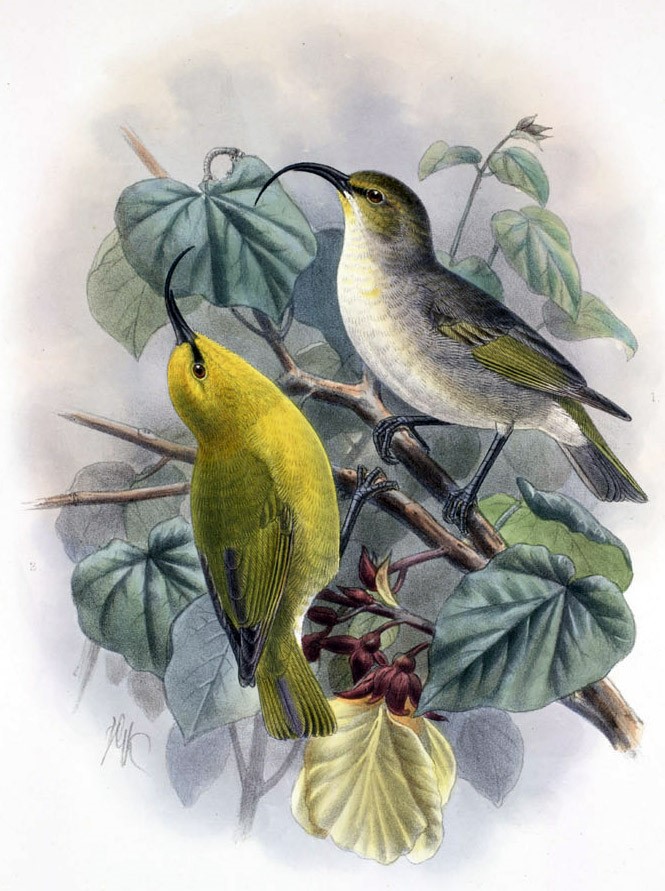Birdfinding.info ⇒ The last incontrovertible record of Kauai Nukupu’u was the collection of two specimens at Makaweli on May 6, 1899. There were few if any reports during the next six decades, until a sighting of two together in the Alakai Swamp on August 16, 1960. Over the next four decades, at least 25 more sightings from the Alakai Swamp followed. None were supported by physical evidence, but some had multiple signatories and persuasive details. The most recent sighting deemed credible enough for the IUCN to mention was reported in 2007. A significant problem with all modern nukupu’u sightings on both Kauai and Maui is the occurrence of amakihis with deformed bills.
Kauai Nukupu’u †
Hemignathus hanapepe
Endemic to Kauai, but presumed to be extinct.
It was known mainly from wet forests of west-central Kauai at elevations of around 600 to 1,200 m.
Identification
A stout, short-tailed honeycreeper with a long, decurved bill, the upper mandible about twice as long as the lower.
The male was mostly bright-yellow with olive upperparts, white undertail coverts, and a strongly defined black mask that merged into the black coloration of the bill.
Females and immatures were mostly olive-gray above and whitish below, with yellowish highlights in the face, wings, and tail.
Compared to the nukupu’us of Oahu and Maui, the male Kauai Nukupu’u had the yellowest plumage and the female Kauai Nukupu’u had the least-yellow plumage.

Kauai Nukupu’u, female and male. Frederick Frohawk, 1899

Kauai Nukupu’u, adult male and immature male. John Gerrard Keulemans, 1900
Notes
Monotypic species. Formerly considered conspecific with Oahu and Maui Nukupu’us, known collectively as the Nukupu’u (Hemignathus lucidus).
IUCN Red List Status: Critically Endangered (Possibly Extinct).
References
BirdLife International. 2018. Hemignathus hanapepe (amended version of 2016 assessment). The IUCN Red List of Threatened Species 2018: e.T103823616A125584125. https://dx.doi.org/10.2305/IUCN.UK.2018-2.RLTS.T103823616A125584125.en. (Accessed May 21, 2020.)
eBird. 2020. eBird: An online database of bird distribution and abundance. Cornell Lab of Ornithology, Ithaca, N.Y. http://www.ebird.org. (Accessed May 21, 2020.)
Hume, J.P. 2017. Extinct Birds (Second Edition). Bloomsbury Publishing PLC, London.
Pratt, H.D. 2005. The Hawaiian Honeycreepers: Drepanidinae. Oxford University Press.
Pratt, H.D., and C.J. Sharpe. 2020. Kauai Nukupuu (Hemignathus hanapepe). In Handbook of the Birds of the World Alive (J. del Hoyo, A. Elliott, J. Sargatal, D.A. Christie, and E. de Juana, eds.). Lynx Edicions, Barcelona. https://www.hbw.com/node/61446. (Accessed May 9, 2020.)
Pyle, R.L., and P. Pyle. 2017. The Birds of the Hawaiian Islands: Occurrence, History, Distribution, and Status. Version 2 (January 1, 2017). http://hbs.bishopmuseum.org/birds/rlp-monograph/. B.P. Bishop Museum, Honolulu, Hawaii.
